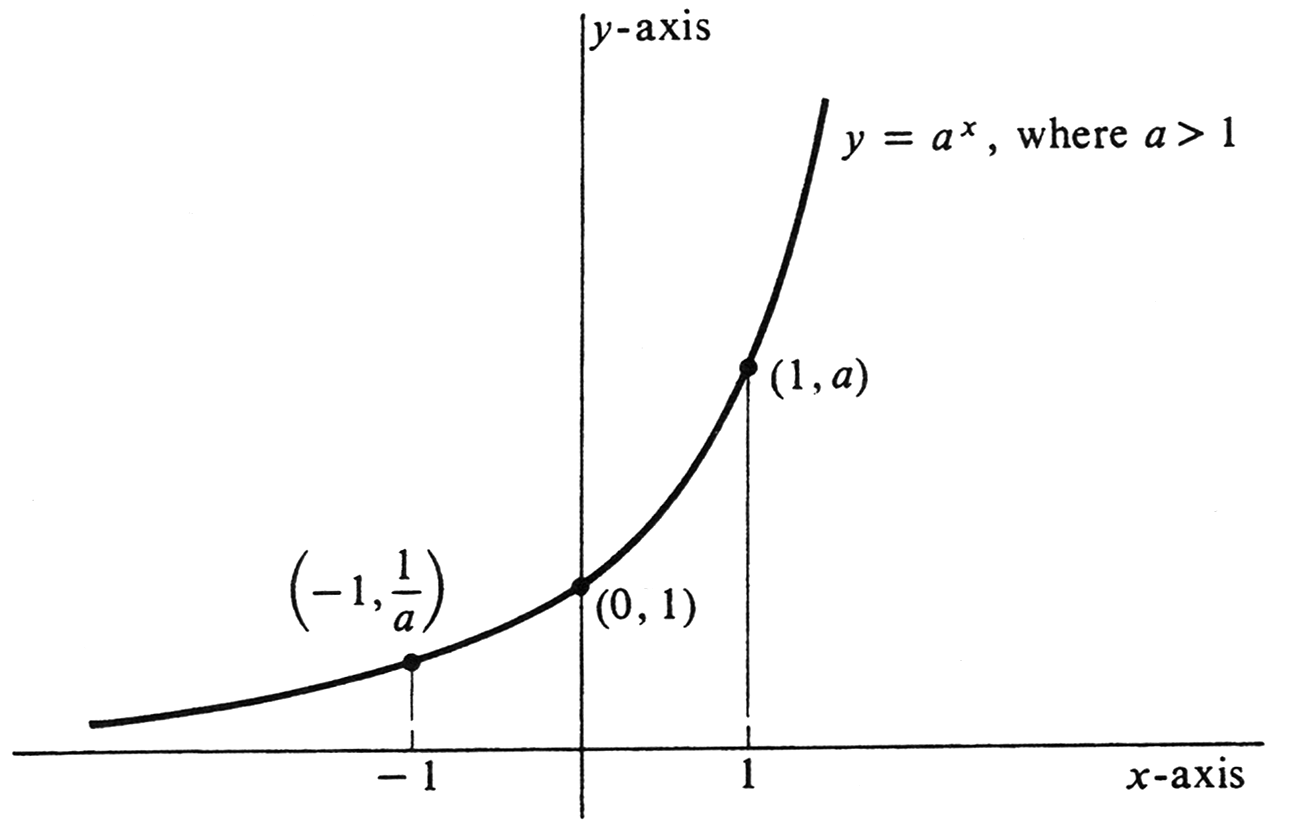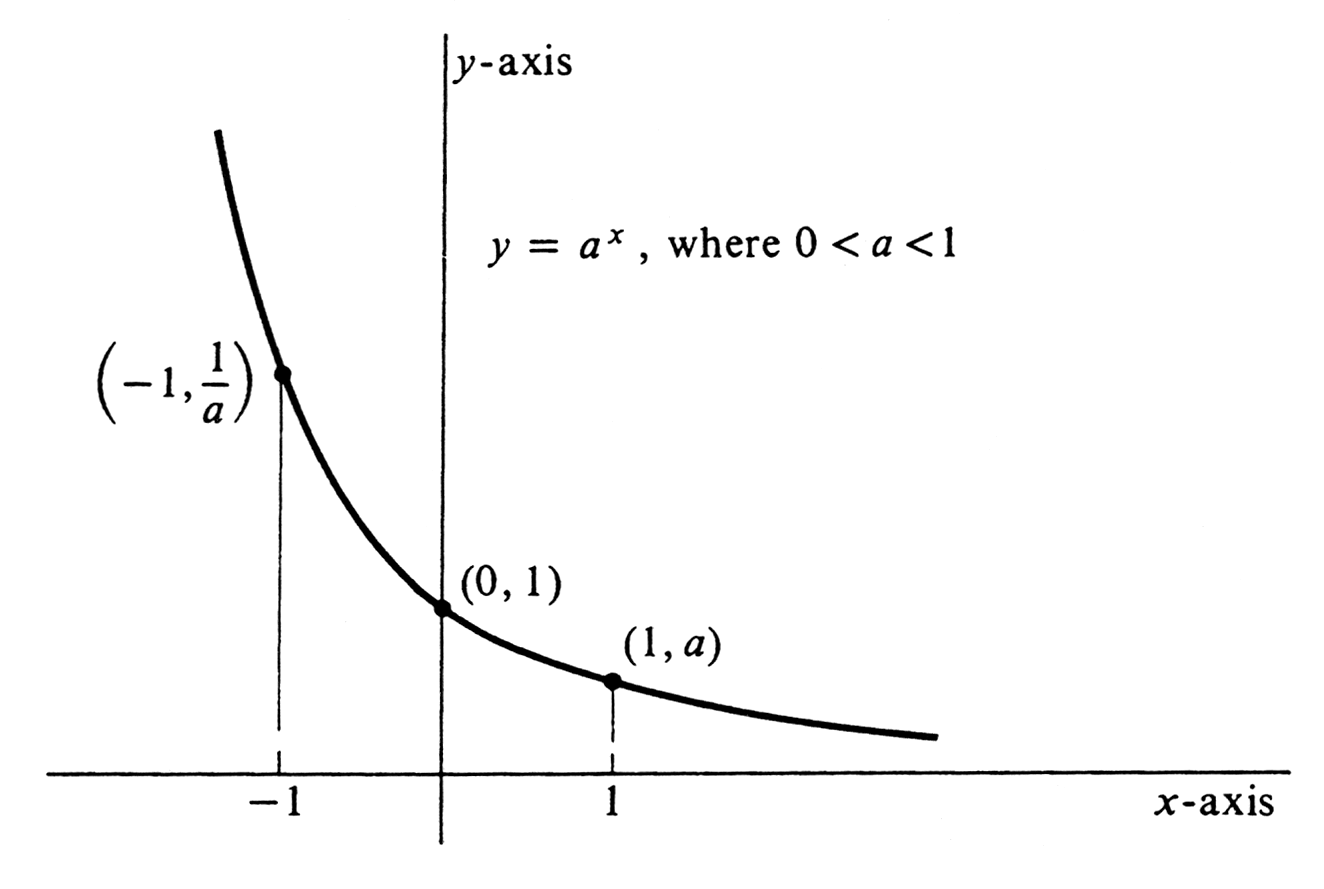Other Exponential and Logarithm Functions
Other Exponential and Logarithm Functions.
If [math]m[/math] and [math]n[/math] are integers and [math]n \gt 0[/math], then
Hence, for any rational number [math]r[/math], the number [math]2^r[/math] is defined. But what is [math]2^x[/math] if [math]x[/math] is not rational? More generally, how should [math]a^x[/math] be defined for an arbitrary real number [math]x[/math] and a positive number [math]a[/math]? If [math]x[/math] is a rational number and [math]a[/math] is positive, we have shown that [math]\ln a^{x} = x \ln a[/math], and therefore [math]a^{x} = e^{x \ln a}[/math]. However, [math]e^{x \ln a}[/math] is defined for every real number [math]x[/math]. We shall take advantage of this fact, and, if [math]x[/math] is real but not rational, we define [math]a^x[/math] to be [math]e^{x \ln a}[/math]. Consequently, for every real number [math]x[/math], we have
This function, so defined, has all the familiar properties of an exponential function:
The proofs follow readily from the properties of the functions [math]\ln[/math] and [math]\exp[/math]. For example,
The derivative of [math]a^{x}[/math] is easily computed from its defining equation. Since
we have the formula
More generally, if [math]u[/math] is a differentiable function of [math]x[/math], the Chain Rule implies that
Example
Compute the derivative of each of the following functions:
For (a) we get
for (b),
and for (c),
If [math]a = 1[/math], then [math]a^{x} = e^{x \ln 1} = e^{0} = 1[/math] for every real number [math]x[/math]. Hence [math]1^{x}[/math] is the constant function 1.
If [math]a \gt 1[/math], then the graph of the function [math]a^{x}[/math] resembles the graph of [math]e^{x}[/math]. The slope of the tangent line to the graph is always positive, for if [math]a \gt 1[/math], then [math]\ln a \gt 0[/math], and, since [math]a^{x} \gt 0[/math], we see that
This means that [math]a^x[/math] is a strictly increasing function (see Problem 10 at the end of this section). The second derivative is also always positive, since
Hence the graph is concave upward for all [math]x[/math]. Moreover, there are no extreme points, critical points, or points of inflection. The graph is drawn in Figure. It is relatively flat on the left, passes through [math]\Bigl( -1, -\frac{1}{a} \Bigr)[/math], (0, 1), and [math](1, a)[/math], and goes upward to the right. For greater values of [math]a[/math], the graph is flatter on the left and steeper on the right.
If [math]0 \lt a \lt 1[/math], the function [math]a^x[/math] may be studied by considering it in another form, [math]\Bigl( \frac{1}{a} \Bigr)^{-x}[/math]. Since [math]\frac{1}{a} \gt 1[/math], the graph of the function [math]\Bigl( \frac{1}{a} \Bigr)^{x}[/math] is of the type described in the preceding paragraph, and the graph of [math]a[/math], which is equal to [math]\Bigl( \frac{1}{a} \Bigr)^{-x}[/math] , is the same curve reflected across the [math]y[/math]-axis. It is steep on the left, passes through [math]\Bigl( -1, \frac{1}{a} \Bigr)[/math], (0, 1), and [math](1, a)[/math], and flattens out as it goes to to the right. It is drawn in Figure. Every derivative formula has a corresponding integral formula. Since
the integral formula corresponding to (4.2) is
As always, the Chain Rule provides a generalization. If [math]u[/math] is a differentiable function of [math]x[/math], then
Example
Compute each of the following indefinite integrals:
A direct use of (4.3) gives for (a)
Since [math]\frac{d}{dx}(x^2 - 7) = 2x[/math], integral (b) can be written [math]\frac{1}{2} \int 10^{x^2 - 7} \cdot 2x \cdot dx[/math], which by (2) is equal to [math]\frac{1}{2} \frac{10^{x^2 - 7}}{\ln 10} + c[/math]. Hence
For part (c) we note that [math]\frac{d}{dx} \ln x = \frac{1}{x}[/math], and therefore that the integral is of the form in (2). Thus
It was proved on page 241 that [math]\ln a^r = r \ln a[/math], for every rational number [math]r[/math] and every positive real number [math]a[/math]. We are now in a position to remove the restriction that [math]r[/math] be rational. Let [math]x[/math] be an arbitrary real number. Then [math]a^x = e^{x \ln a}[/math], and so [math]\ln a^x = \ln e^{x \ln a} = \ln \exp(x \ln a)[/math]. Since [math]\ln[/math] and [math]\exp[/math] are inverse functions of each other it follows that [math]\ln \exp(x \ln a) = x \ln a[/math]. We have therefore proved that
[math]\ln a^x = x \ln a[/math], for every real number [math]x[/math] and every positive real number [math]a[/math].
Another of the well-known laws of exponents now follows easily:
[math](a^x)^y = a^{xy}[/math] for all real numbers [math]x[/math] and [math]y[/math] and every positive real number [math]a[/math].
If we let [math]a^x = b[/math], then [math](a^x)^y = b^y = e^{y \ln b}[/math]. Replacing [math]b[/math] in the last expression, we have
In particular, [math](e^x)^y = e^{xy}[/math] for all real numbers [math]x[/math] and [math]y[/math]. Let [math]a[/math] be any real number, and consider the function [math]f[/math] defined for every positive real number [math]x[/math] by
Hitherto in this section we have considered the function [math]a^x[/math]. Now we reverse the roles of constant and variable. One of the basic rules of differentiation proved in Chapter 1 states that, if [math]a[/math] is a rational number, then
We now remove the restriction that [math]a[/math] be rational. Observe first that [math]x^a[/math] is certainly a differentiable function, since it is the composition of differentiable functions:
Knowing this, we use implicit differentiation to compute its derivative. Let [math]y = x^a[/math]. Then [math]\ln y = \ln x^a = a \ln x[/math], and so
Since [math]y = x^a[/math], it follows that [math]\frac{ay}{x}=\frac{ax^a}{x}= ax^{a-1}[/math]. Thus we have proved that
The technique of taking logarithms and differentiating implicitly, which was used in proving, can also be used to compute the derivative of a positive differentiable function which is raised to a power which is itself a differentiable function. For example, to compute [math]\frac{d}{dx} x^{x}[/math], we let [math]y = x^{x}[/math]. Then
and it follows that
This technique is known as logarithmic differentiation and is a basic tool for finding derivatives. We can use it to derive a formula for [math]\frac{d}{dx} u^{v}[/math], where [math]u[/math] is a positive differentiable function of [math]x[/math] and [math]v[/math] is any differentiable function of [math]x[/math]. Let [math]y = u^v[/math], and then [math]\ln y = v \ln u[/math]. Hence
and finally, therefore,
We do not suggest that the reader memorize this formula. It is more important to be able to use the method of logarithmic differentiation.
\medskip
Example
Find [math]\frac{d}{dx} (x^2 + 1) ^{e^x}[/math]. Letting [math]y = (x^{2} + 1)^{e^x}[/math] and taking natural logarithms, we have
Differentiating, we obtain
Hence
The function [math]a^x[/math] is strictly monotonic if [math]a[/math] is positive and not equal to 1, increasing if [math]a \gt 1[/math] and decreasing if [math]0 \lt a \lt 1[/math]. Moreover, it has a nonzero derivative at every [math]x[/math]. It follows by Theorem (3.4), page 261, that [math]a^x[/math] has a differentiable inverse function. Even as the inverse function of [math]e^x[/math] is the natural logarithm, we call the inverse function of [math]a^x[/math] the logarithm to the base [math]a[/math]. Hence
We emphasize that [math]a[/math] must be a positive number different from 1 and that [math]\log_{a}x[/math] is defined only for positive values of [math]x[/math]. The so-called common logarithm, usually denoted by simply log and encountered in the usual tables of logarithms, is the logarithm to the base 10. Thus [math]\log 100 = \log_{10} 100 = 2[/math], since [math]10^2 = 100[/math]. The logarithm to the base a has the same algebraic properties as the natural logarithm:
The above properties hold for every positive real number [math]a[/math] different from 1, for all positive real numbers [math]p[/math] and [math]q[/math], and for every real number [math]b[/math]. Each one may be proved by considering the corresponding exponential function. Note that since [math]a^x[/math] and [math]\log_{a}x[/math] are inverse functions of each other,
For example, if we let [math]x = \log_{a}p[/math] and [math]y = \log_{a}q[/math], then we have [math]p = a^{x}[/math] and [math]q = a^{y}[/math], and so
The other properties are proved in the same way.
To compute the derivative of [math]\log_{a}x[/math], we let [math]y = \log_{a}x[/math]. The equivalent exponential equation is [math]x = a^y[/math], from which it follows that [math]\ln x = \ln a^y = y \ln a[/math]. By implicit differentiation, therefore,
Solving for [math]\frac{dy}{dx}[/math], which equals [math]\frac{d}{dx} \log_{a}x[/math], we obtain
\end{exercise}
General references
Doyle, Peter G. (2008). "Crowell and Slesnick's Calculus with Analytic Geometry" (PDF). Retrieved Oct 29, 2024.

